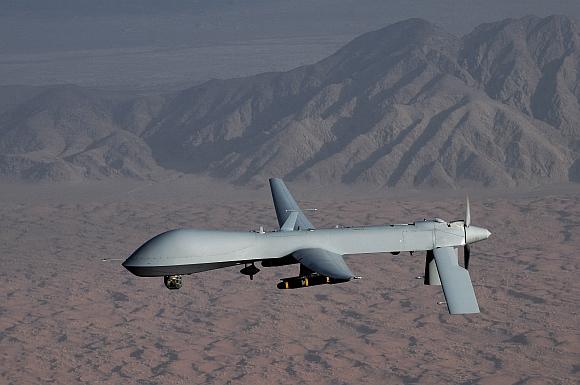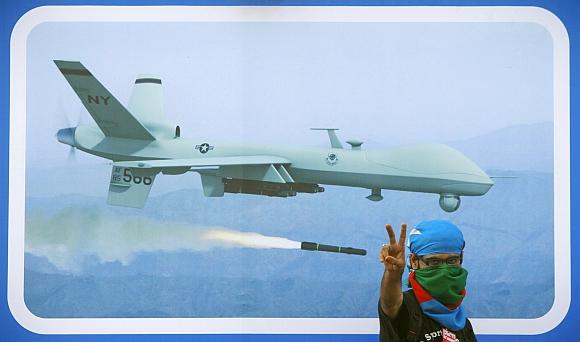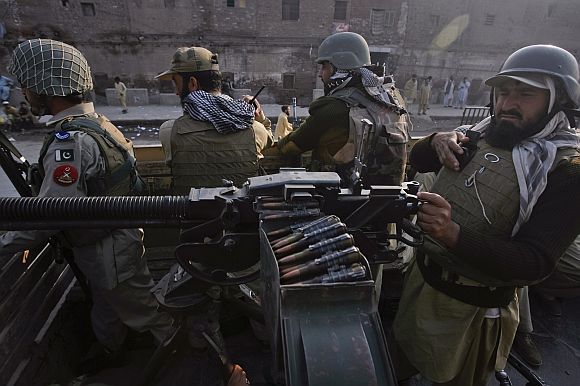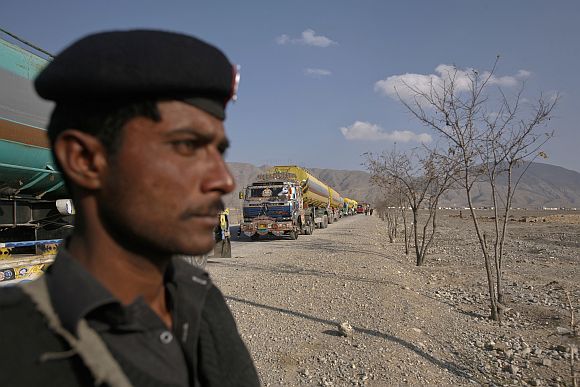
US drones targetting terrorist camps in Pakistan's tribal belt have fallen silent for the last one month, since the Mohmand incident in which NATO strikes on two checkposts killed 24 Pakistani soldiers. But the pause is likely to be temporary, reports Amir Mir
The CIA-run American drone attacks targetting the hideouts of the Al Qaeda and Taliban linked terrorists operating from Pakistani tribal belt has entered its longest pause in recent years, as the Americans have not launched any Predator or Reaper strike inside Pakistan for over a month now.
However, if recent history is any example, the current pause in the American drone attacks is temporary and the American Predators will resume their operations in Pakistani territory as soon as Islamabad restores the North Atlantic Treaty Organisation supply routes.
The routes have been suspended since the November 26 NATO air strike that killed 24 Pakistani soldiers on two checkposts in the Mohmand tribal agency.
Having carried out 71 deadly attacks inside Pakistani territory between January 1 and November 17, 2011, the American drones seem to be in abeyance for a month now, as had been the case following the arrest of Raymond Davis, an under-cover CIA agent who was charged with double-murder for killing two youngsters in Lahore.
Following the arrest of Davis on January 27, 2011, US drones stopped attacking Pakistani territory for almost a month and conducted only one Predator strike in the month of February 2011. But immediately after Davis was set free on March 16, 2011, after the families of the deceased men were paid $2.5 million as blood money, the drone campaign had once again intensified.
...

The 35-day long gap in strikes is the longest since another pause that took place in the spring of 2009 (28 days, May 16 to June 14). US officials attributed that gap to operational issues with the unmanned aircraft.
The third- and fourth-longest pauses also took place earlier this year, during a time of high tensions with Pakistan. A 27-day long gap in strikes from January 23 to February 20, 2011 occurred after the Davis episode.
And a 25-day long gap from March 17 to April 13 took place after the US killed dozens of Pakistanis in a strike in North Waziristan.
That strike killed a senior Taliban leader and 11 fighters along with an estimated 30 tribesmen who were said to be negotiating mineral rights in the area. Several members of the Inter Services Intelligence were rumoured to have also been killed in the strikes.
The Pakistani authorities have repeatedly protested the US drone attacks targetting the alleged hideouts of Al Qaeda and Taliban-linked elements in the Pak-Afghan tribal belt, describing them as an infringement of its sovereignty which is causing civilian deaths also.
However, since the Obama administration is adamant about carrying on with its campaign, the US drones have conducted 71 Predator strikes in 2011 (until December 21), showing a monthly average of over six attacks.
...

Before the November 26 strike, which prompted Pakistan to suspend the NATO supply lines and ask the Americans to vacate the Shamsi air base, the drones had carried out four Predator strikes inside Pakistani territory during that month.
These attacks were conducted on November 3, 2011 (killing three people in North Waziristan, suspected as being Haqqani militants), November 15 (killing seven militants in a compound in North Waziristan), November 16 (killing 16 people, two of whom were Tehreek-e-Taliban militants in South Waziristan), and November 17 (killing six suspected militants killed in North Waziristan).
But in the aftermath of the unwarranted killing of 24 Pakistani soldiers and the subsequent retaliatory actions taken by Islamabad, including its decision to boycott the Bonn conference on Afghanistan, the CIA has apparently put on hold its drone campaign.
In an apparent replay of the post-Davis arrest situation, when the drone campaign was suspended for a month, the Americans have conducted only one attack ever since the November 26 air strike.
According to the American media, senior US officials fear that another drone attack at this crucial juncture would further damage the already fragile Pak-US relationship. Yet, well-informed diplomats in Islamabad say the drone campaign has only been suspended temporarily keeping in view the uncertain situation arising out of the NATO air strike.
According to them, senior US government officials consider drone attacks to be very successful and believe that the senior Al Qaeda leadership has literally been devastated by these strikes alone.
...

Therefore, diplomats say, the drone attacks would be resumed to hunt down high-value Al Qaeda and Taliban targets as soon as Pak-US ties are back to normal and the suspended NATO supply routes (from Pakistan to Afghanistan) are restored.
On the other hand, some well-placed officials in the Pakistani security establishment insist that it would be hard for the Americans to continue with their Predator campaign with the same velocity, especially after they have been made to vacate Shamsi air base which had been of great help to the Americans in their drone campaign.
The Pakistani airbase had been used by the American forces to stage elements of a clandestine US counter-terrorism operation to attack encampments of militants linked with the Al Qaeda and the Taliban, using unmanned drone aircraft armed with missiles.
But diplomatic circles in Islamabad say the eviction of the Americans from the Shamsi base would have little impact on the American drone campaign.
According to them, the base was more of a maintenance and refueling base for the American drones while most of the operations were being conducted from across the border in Afghanistan where the Americans have set up Forward Operating Base Chapman (also called Camp Chapman), to conduct its drone operations.
Besides getting the Shamsi air base vacated, Pakistani military authorities have further announced shooting down any US drone in future that intrudes its airspace. As per the new defence policy, any object entering the Pakistani airspace, including American drones, will be treated as hostile and shot down.
Army Chief General Ashfaq Kayani had already issued multiple directives since the NATO attack, which included orders to shoot down drones.
...

However, diplomatic circles argue that the drone campaign was being conducted with the involvement of the Pakistani military authorities with a view to nip the evil of Al Qaeda and Taliban in the bud and Islamabad's decision to abandon this partnership would also affect Pakistan negatively.
The utility of the drone strikes in eliminating some of the most wanted terrorists had been admitted by the officer in charge of the Pakistani troops in North Waziristan, general officer commanding of 7th-Division, Major General Ghayur Mehmood, in an official briefing titled Myths and rumours about US Predator strikes.
Speaking on the occasion on March 9, 2011, he said, 'Myths and rumours about American Predator strikes and the casualty figures are many, but it's a reality that many of those being killed in these strikes are hardcore elements, a sizeable number of them foreigners.
'Yes, there are a few civilian casualties in precision strikes, but a majority of those eliminated are Al Qaeda and Taliban-linked terrorists, including foreign elements. Between 2007 and 2011, 164 Predator strikes had been carried out, killing over 964 terrorists. Of those killed, 793 were locals and 171 foreigners,' he added.